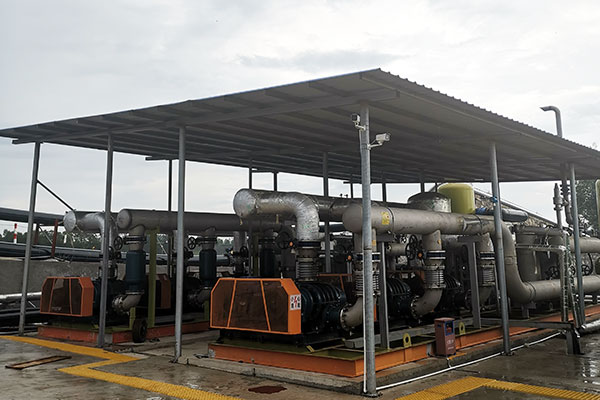To comprehend the application of Roots vacuum pumps, one must first understand what a vacuum pump is.
What is a Roots vacuum pump
The Roots vacuum pump, also known as a Roots blower or Roots blower pump, is a mechanical rotary exhaust pump that comprises two meshing rotating impellers. The impellers rotate inside the pump, forcing air out of the inlet side and then discharging it to the outlet side to create a vacuum environment.

A Roots vacuum pump typically comprises a stator shaft and a rotor that rotates on the stator shaft or is driven by a gear to rotate. The housing of the Roots pump and the vanes on the rotor create a small gap, which pumps and compresses gas. When gas enters the Roots vacuum pump, the vanes start to rotate, and they bring the gas to the pump outlet, creating a vacuum.
Users typically employ Roots vacuum pumps in applications requiring high flow rates and low to medium vacuum, such as semiconductor manufacturing, vacuum cooling, vacuum packaging, vacuum ovens, and laboratory research.
Applications of Roots vacuum pumps
A Roots vacuum pump finds common usage as a mechanical vacuum pump to create a vacuum environment by pumping gases out of a closed vessel or pipe. There are various applications for the Roots vacuum pump, including the following.

- Semiconductor manufacturing: Users employ Roots vacuum pumps to pump gases out of closed vessels or pipes in semiconductor manufacturing processes, such as semiconductor wafer fabrication and lithography.
- Vacuum cooling: Vacuum cooling equipment, such as in magnetic resonance imaging (MRI) equipment, utilizes Roots vacuum pumps to create a cryogenic environment by extracting gas from the coolant, enabling more accurate imaging.
- Vacuum packaging: Roots vacuum pumps facilitate the vacuum packaging of food, pharmaceuticals, cosmetics, and other items by extracting oxygen and other gases from bags, extending the products’ shelf life.
- Vacuum furnaces: In vacuum furnaces, Roots vacuum pumps extract gas from the furnace, creating a high-temperature, high-vacuum environment that can be used for material processing and heat treatment.
- Laboratory and scientific research: In various laboratory and scientific research applications, such as in physics, chemistry, and biology experiments, Roots vacuum pumps create high vacuum environments and pump out gases from samples.
Classification of Roots vacuum pumps
Roots vacuum pump manufacturers classify Roots vacuum pumps into different types based on various methods, which are commonly as follows:
- Single-stage Roots pump: It comprises a pair of coaxially rotating impellers and serves primarily for pumping in the low vacuum and rough vacuum range.
- Two-stage Roots pump: This type of Roots pump adds a second impeller to the single-stage Roots pump, allowing for the acquisition of a higher vacuum.
- Atmospheric pressure start Roots pump: This Roots pump can initiate operations from the atmospheric pressure state, owing to its atmospheric pressure start function.
- High-temperature Roots pump: It is ideal for gas pumping in high-temperature environments and is applicable to heat treatment and melting industries.
- Magnetic levitation Roots pump: This Roots pump adopts magnetic levitation technology to realize axial and radial contactless rotation, thereby avoiding issues such as wear and lubrication of the pump body caused by friction.
- Water ring Roots pump: This Roots pump combines a water ring vacuum pump with a Roots pump, enabling the attainment of high vacuum and suiting applications such as high evaporation loads and distillation that require a large amount of gas pumping.


